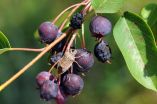(Press-News.org) The brown marmorated stink bug has a bad reputation. And for good reason: every summer, this pest attacks crops and invades homes, causing both sizable economic losses and a messy, smelly nuisance--especially in the eastern United States. A new study by entomologists at the University of Maryland shows that these pests, known simply as stink bugs, have a strong preference for ripe fruit. Moreover, stink bugs track their favorite fruits throughout the growing season in an effort to maximize their access to food.
The study, published online June 25, 2015 in the Journal of Pest Science, reports the numbers of stink bugs feeding on nearly 4,000 fruit-bearing ornamental trees representing more than 200 popular varieties grown for sale at commercial nurseries. The researchers found that trees with ripe fruit attracted more than twice as many adult stink bugs compared with trees bearing immature fruit. Moreover, when the researchers removed all fruit from more than 30 trees, stink bugs lost interest and almost totally disappeared from those trees.
The findings could help guide strategies to control stink bug populations. By preferentially planting fruitless varieties of ornamental trees and/or planting varieties that bear fruit early in the growing season when the number of stink bugs is lower, landscapers and homeowners could become a crucial line of defense in the annual battle to control this damaging invasive pest.
"Stink bugs have captured the public's attention like no other insect in recent memory. They get into people's homes, fly around their bedrooms and spend the winter in their boxes of holiday decorations. People love to hate this bug," said Holly Martinson, a research associate in entomology at UMD and lead author of the study. "What's worse is the damage stink bugs cause to agriculture, which we have only just begun to quantify."
Because of the toll that stink bugs can exact on agricultural crops, most stink bug studies have focused on single, economically important crops such as apples, peaches, soybeans and corn. But stink bugs are currently known to attack at least 120 plant species. Thus, Martinson and her colleagues focused on a wide variety of ornamental trees in nurseries, where food availability for stink bugs is sporadic and unpredictable, to more closely reflect the real-world dining habits of these voracious pests.
"The stink bug's generalist diet helps explain its success as an invasive species," said Michael Raupp, a professor of entomology at UMD and co-author of the study. The infamous brown marmorated stink bug was first introduced to the United States in the late 1990s, but is native to China, Taiwan and Japan. "The world is not a monoculture. It is filled with different plants fruiting at different times. Odds are that when the stink bug arrives in a new environment, something will be fruiting. The smorgasbord is always set."
The current study provides some critical intelligence in the battle against stink bugs and their annual buffet of destruction. Stink bugs spend the winter in human-made structures, where they lay dormant in eaves, rafters and storage areas. When they first emerge in the spring and begin laying eggs, their main source of food is not agricultural crops, but rather fruit-bearing ornamental trees commonly found near homes and along city streets. As these sources of food become depleted and/or the fruit begins to decline in quality, stink bugs move on to other plant varieties that are hitting their peak.
In late summer and early fall, when stink bugs begin seeking shelter for the winter, they will take advantage of late-fruiting ornamental trees near homes and other buildings. Thus, limiting the availability of fruit both in spring and fall could prove to be the one-two punch needed to control stink bug populations.
"We knew that stink bugs like fruit, but it was surprising to find that the bugs could accurately track ripening fruit across space and time," said Dilip Venugopal, a research associate in entomology at UMD and co-author of the study. "Now we can use this information for controlling and monitoring. Knowing the habits and preferences of stink bugs will save a lot of time and allow for focused management efforts."
The team is creating a list of ornamental tree species that stink bugs prefer. Eventually, this list could help inform landscapers and homeowners which species of trees to avoid planting, especially close to homes and other structures. On the other hand, stink bugs will ignore some trees altogether, either because their fruit is unappealing or they do not bear fruit at all. Building this second list of tree species that stink bugs avoid is also a high priority for the researchers.
Given the ubiquity of stink bugs in the summer months, the researchers have plans to involve the broader community in future efforts.
"We hope that our study will foster citizen science research projects in collaboration with universities," said Paula Shrewsbury, an associate professor of entomology and extension specialist at UMD who is also a co-author of the study. "For example, the fruit removal experiment we conducted can be expanded to residential landscapes, with the voluntary help of homeowners and their children."
INFORMATION:
This work was supported by the U.S. Department of Agriculture's National Institute of Food and Agriculture (Award Nos. 1003486 and 2011-51181-30937). The content of this article does not necessarily reflect the views of this organization.
The research paper, "Fruit availability influences the seasonal abundance of invasive stink bugs in ornamental tree nurseries," Holly Martinson, Dilip Venugopal, Erik Bergmann, Paula Shrewsbury, and Michael Raupp, was published online June 25, 2015 in the Journal of Pest Science.
Media Relations Contact: Matthew Wright, 301-405-9267, mewright@umd.edu
University of Maryland
College of Computer, Mathematical, and Natural Sciences
2300 Symons Hall
College Park, MD 20742
http://www.cmns.umd.edu
@UMDscience
About the College of Computer, Mathematical, and Natural Sciences
The College of Computer, Mathematical, and Natural Sciences at the University of Maryland educates more than 7,000 future scientific leaders in its undergraduate and graduate programs each year. The college's 10 departments and more than a dozen interdisciplinary research centers foster scientific discovery with annual sponsored research funding exceeding $150 million.
PHILADELPHIA -- Since their discovery in the 1950s, transfer RNAs (tRNAs) have been best known for their role in helping the cell make proteins from messenger RNA templates. However, recent studies have led to a previously-unsuspected concept that tRNAs are not always the end product; namely, they further serve as a source of small RNAs. Now researchers have discovered a new species of tRNA-derived small RNAs that are produced only in hormonally-driven breast and prostate cancers, and which contribute to cell proliferation. The results will be published online the week ...
The warm temperature on a summer's day is often a time for relaxing, but researchers from the University of Leicester have suggested that a 'thermosensory' gene could be responsible for changes in behaviour in different climates.
The researchers from the University of Leicester's Department of Genetics have explored how the biological clock can be affected by the environment by examining the fruitfly Drosophila melanogaster, which shows 24 hour biological cycles and is used as a model organism for studies into human rhythms.
Like many humans, the fly has a 'siesta' ...
It's been difficult to explain patterns of toxic mercury in some parts of the world, such as why there's so much of the toxin deposited into ecosystems from the air in the southeastern United States, even upwind of usual sources.
A new analysis led by researchers at the University of Colorado Boulder shows that one key to understanding mercury's strange behavior may be the unexpected reactivity of naturally occurring halogen compounds from the ocean.
"Atmospheric chemistry involving bromine and iodine is turning out to be much more vigorous than we expected," said ...
A University of Oklahoma professor studying malaria mosquito interaction has discovered a new mosquito protein for the development of a new vaccine that is expected to stop the spread of the disease in areas where it is considered endemic. Malaria is transmitted by mosquitoes, and it infects millions of people in Africa, Asia and South America every year, causing a global health crisis. In addition to the local populations, U.S. military personnel stationed in these areas and travelers to these malaria-prone areas are at risk of becoming infected.
Jun Li, assistant ...
UC Santa Barbara geologist Jim Boles has found evidence of helium leakage from the Earth's mantle along a 30-mile stretch of the Newport-Inglewood Fault Zone in the Los Angeles Basin. Using samples of casing gas from two dozen oil wells ranging from LA's Westside to Newport Beach in Orange County, Boles discovered that more than one-third of the sites -- some of the deepest ones -- show evidence of high levels of helium-3 (3He).
Considered primordial, 3He is a vestige of the Big Bang. Its only terrestrial source is the mantle. Leakage of 3He suggests that the Newport-Inglewood ...
WASHINGTON (June 29, 2015) -The American College of Cardiology, Heart Rhythm Society and Society for Cardiovascular Angiography and Interventions today released a new overview on the implantation of left atrial appendage occlusion devices.
The implantation of left atrial appendage occlusion devices may lower the risk of stroke in patients with atrial fibrillation. As new devices are developed, it is anticipated that the use of left atrial appendage occlusion technologies in clinical practice will expand. The authors of the paper urge that the new technology should be ...
Stringing together meaningless sounds to create meaningful signals was previously thought to be the preserve of humans alone, but a new study, publishing June 29th in the Open Access journal PLOS Biology, has revealed that babbler birds are also able to communicate in this way.
Researchers at the Universities of Exeter and Zurich discovered that the chestnut-crowned babbler - a highly social bird found in the Australian Outback - has the ability to convey new meaning by rearranging the meaningless sounds in its calls. This babbler bird communication is reminiscent of ...
LAKEVILLE-MIDDLEBORO, Mass., (June 29, 2015) - A new study (1) reveals that drinking low-calorie cranberry juice cocktail may help lower the risk of chronic diseases that rank among the leading causes of death worldwide, including heart disease, diabetes and stroke. The finding is welcome news considering the World Health Organization estimates the trio of diseases annually claim 15.6 million lives around the globe (2). These illnesses are among the most common and costly health conditions, but fortunately, they are also among the most preventable through dietary intervention. ...
An overview and analysis of the factors underlying the recent Middle East Respiratory Syndrome coronavirus (MERS-CoV) outbreak in Korea has been published online ahead of print in the American Thoracic Society's American Journal of Respiratory and Critical Care Medicine.
"On 20 May 2015, the Republic of Korea confirmed the first case of MERS-CoV infection in a 68 year old male who had returned to Seoul after traveling to 4 countries in the Middle East," write co-authors David S Hui, MD, of the Chinese University of Hong Kong, and Malik Peiris, DPhil, of the University ...
MAYWOOD, Ill. - At least 14 deaths of marathon runners, football players and other athletes have been attributed to a condition called exercise-associated hyponatremia, which results from drinking too much water or sports drinks.
But there's an easy way to prevent hyponatremia, according to new guidelines from an international expert panel: Simply put, drink only when you're thirsty.
"Using the innate thirst mechanism to guide fluid consumption is a strategy that should limit drinking in excess and developing hyponatremia while providing sufficient fluid to prevent ...


